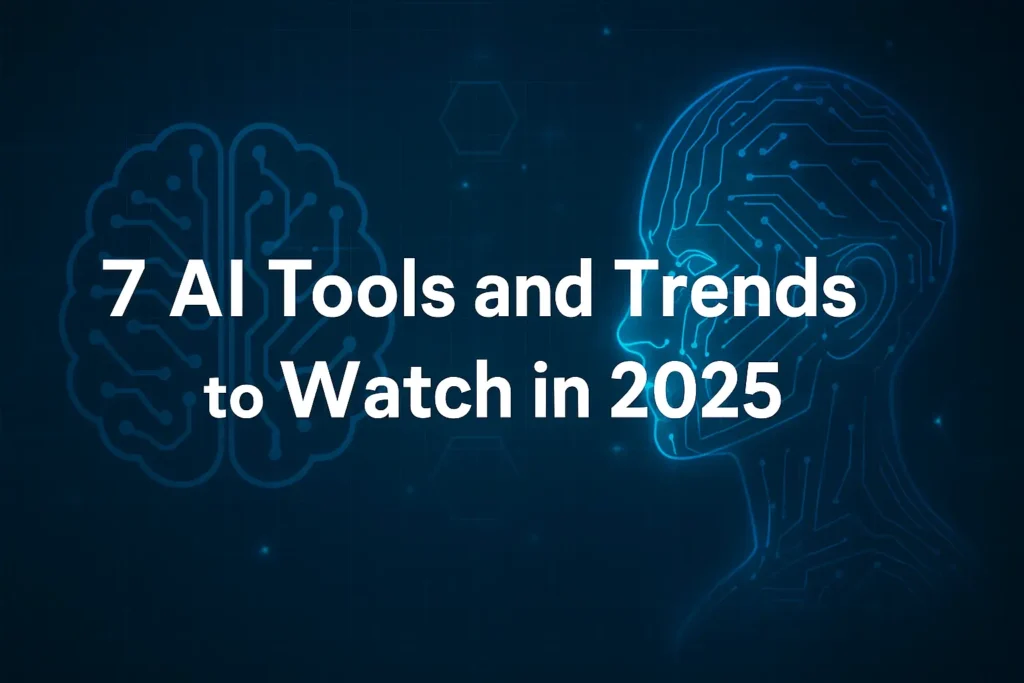Every year, people say, “This is the year of AI.” Well, 2025 actually feels like it. AI has quietly moved from being a fun experiment into something we bump into almost every day—whether it’s the way we get our news, shop online, or even book a doctor’s appointment. A couple of years ago, we were playing around with chatbots that barely understood a question. Now? AI is writing articles, designing ads, helping doctors, and (let’s be honest) quietly replacing the boring parts of a lot of jobs.
So, what’s actually worth paying attention to this year? Here are seven AI tools and trends in 2025 that I think are changing the game.
1. Generative AI Isn’t a Toy Anymore
Remember when generative AI was mostly about asking a chatbot silly questions or making pixelated art? Those days are gone. Tools like ChatGPT-5, Google Gemini, and Claude are everywhere—baked right into productivity apps, design software, and even personal devices.
The coolest upgrade? The coolest part is how personal they’ve become. Instead of spitting out generic text, they actually learn your style. I’ve seen marketers use them to write campaigns that sound just like their brand voice, and teachers who get lesson plans tailored to their students. That’s already being used by educators, marketers, and creators, and the list can go on. And the personalization is wild. These tools can actually learn your style and sound like you. It’s no longer generic “robot talk.”
2. Automation That Feels Like a Smart Colleague
For years, “automation” meant setting up a few if-this-then-that rules and hoping they worked. But in 2025, platforms like UiPath, Zapier AI, and Microsoft Power Automate have gotten smart enough to make their own calls.
Instead of just “if this, then that,” they actually decide things. For example, they can spot when a customer might be losing interest and pick the best way (and best time) to reach out. That’s not just saving time—that’s helping businesses actually keep customers happy.
Honestly, it frees up humans to work on stuff that matters instead of clicking the same buttons all day
To me, it feels less like software and more like having a quiet coworker who handles the boring stuff while you focus on the interesting parts.
3. Security and Ethics Aren’t Optional Anymore
The truth is, AI can be a double-edged sword. Deepfakes are getting scarily realistic, biased algorithms can cause real harm, and data privacy… let’s just say it’s a touchy subject.
That’s why there’s a whole new wave of AI security tools. Platforms like AI Shield, IBM Watson Security, and Palo Alto Cortex AI are tackling deepfake detection, data protection, and bias correction. Platforms like AI Shield, IBM Watson Security, and Palo Alto Cortex AI are stepping in to detect fake content, clean up bias, and keep data safe.
And honestly? Customers care. In 2025, trust might be just as important as speed or price. If your AI isn’t transparent, people will walk away.
4. Healthcare Is Where AI Feels Like Magic
Out of all industries, healthcare might be the one where AI feels the most life-changing. If there’s one industry where AI makes me go “wow”, it’s healthcare. Tools like DeepMind Health, PathAI, and Tempus are helping doctors do things that sounded impossible a decade ago.
As someone who’s followed tech for years, this is the part that feels closest to science fiction—except it’s real.
5. Edge AI: Decisions Without the Cloud Lag
Here’s a trend that doesn’t get flashy headlines but is super important: Edge AI. Basically, instead of sending all your data to the cloud and waiting for answers, devices themselves are smart enough to decide instantly.
Think self-driving cars, drones, and factory robots. They don’t have time to “phone home” before acting. With tools like NVIDIA Jetson, Intel OpenVINO, and AWS IoT Greengrass, they don’t have to.
The payoff? Faster responses, less energy, and more reliable systems. Not glamorous, maybe, but in industries where a second can make or break safety, this matters a lot.
6. Creativity Gets a Serious Boost
This one’s fun. AI isn’t stealing creativity—it’s amplifying it. Tools like Adobe Firefly, Runway ML, and Canva AI Studio are letting people who never touched Photoshop make polished designs, videos, and even music.
I’ve seen small businesses crank out professional-looking ads in a day. I’ve seen YouTubers generate entire video concepts—script, visuals, soundtrack—in an afternoon.
You still need ideas (AI won’t dream for you), but the barrier to making something beautiful is lower than ever.
7. Predictive AI: Playing Chess, Not Checkers
The last trend does not grab headlines but quietly runs the world: predictive AI. Tools like SAS Viya, Oracle AI, and DataRobot are helping businesses spot problems before they happen.
Picture this: knowing a shipment will be delayed two weeks before it even leaves the port. Or predicting which customers are about to leave so you can keep them happy. That’s not science fiction—it’s happening right now.
Instead of reacting, companies can plan. And in 2025, being proactive is everything.
Final Thoughts
Looking across these seven trends, the pattern is obvious: AI isn’t just helping anymore—it’s leading. It’s in our offices, our hospitals, our creative projects, even our supply chains.
The real question for businesses and individuals isn’t “should I use AI?” It’s “how quickly can I learn to work with it before I get left behind?”
Because ready or not, the future isn’t waiting. It’s already here—and it’s moving at AI speed.


2 Responses
Thank you for the good writeup. It in fact was a amusement account it. Look advanced to far added agreeable from you! By the way, how could we communicate?
Thank you so much! 😊 I’m really happy you enjoyed the write-up. I appreciate your kind words and interest! The best way to stay in touch is right here through the blog — you can leave comments or reach out via the contact page.